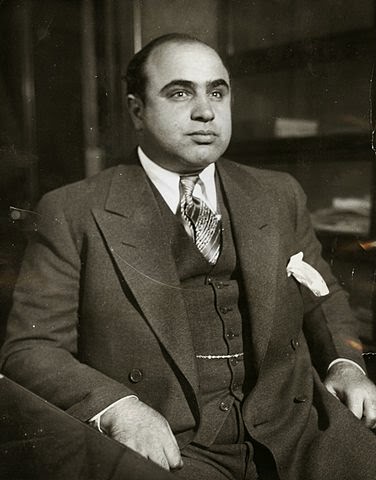 |
| Capone in 1930 (FBI) see below* |
By Jane Feehan
Al Capone folklore in Florida is nearly as ubiquitous as that of George Washington visiting towns during America's War for Independence.
The storied visits of our first president were based on fact. Not so with gangster Capone. Yes, he did live and die on Miami’s Palm Island. He did drive up the South Florida coast for recreation and to seek business opportunities during the boom times of the 1920s. But he did not buy what became known as “Capone Island” in the Intracoastal Waterway off Deerfield Beach.
The storied visits of our first president were based on fact. Not so with gangster Capone. Yes, he did live and die on Miami’s Palm Island. He did drive up the South Florida coast for recreation and to seek business opportunities during the boom times of the 1920s. But he did not buy what became known as “Capone Island” in the Intracoastal Waterway off Deerfield Beach.
During 1928 or 1929, the gangster and a few friends stopped at a speakeasy just south of Boca Raton, where Capone viewed a peninsula jutting out into the water off the north bank of the Hillsboro Canal west of the Intracoastal Waterway. The secluded, vacant property probably looked like an ideal place to conduct some bootlegging biz during Prohibition. Capone made an offer for the southeast portion of the peninsula.
A Saint Petersburg, FL, newspaper reported in 1930 that Judge Vincent C. Giblin, “chief of Al Capone’s legal staff in Miami,” was going to buy the property where Capone was to build a residence for $250,000 and a pool for $125,000. This was, no doubt, hyperbole. The Chicago gangster had paid only $40,000 for his Miami Palm Island digs in 1928. The reporter editorialized that Capone’s “presence in Miami is destructive; his presence in Broward County, close to the Boca Raton Club in Palm Beach County, will be destructive to the club and both counties.”
The state was willing to make a deal but the transaction never materialized for two reasons: Boca Raton residents did not want Capone in the neighborhood and the state wanted a road to be built on the property. The road was the deal breaker; Capone walked away. Anyway, he would not have had much time to enjoy it. In 1932, at 33 years old, he was convicted of tax evasion and sent to Alcatraz for seven years.
Today the 53-acre property is Deerfield Island, operating as a Broward County park since 1981 after it was leased from the state for 99 years. Waterway dredging during the 1960s created a canal, which turned the peninsula into an island (Capone's vision?) The park serves as a popular Boy Scout camp, wildlife refuge and recreational area for boaters and hikers. Copyright © 2015. All rights reserved. Jane Feehan.
See more on Capone on this blog.
Evening Independent, Saint Petersburg, FL. July 19, 1930
The Day, New London, CT, Jan. 25, 1985
"Al Capone in 1930" by Wide World Photos, Chicago Bureau (Federal Bureau of Investigation) - http://gottahaveit.com/Al_Capone_Original_1930_s_Wire_Photograph-ITEM14763.aspx. Licensed under Public domain via Wikimedia Commons - https://commons.wikimedia.org/wiki/File:Al_Capone_in_1930.jpg#mediaviewer/File:Al_Capone_in_1930.jpg
Tags: Al Capone, Capone in Florida, Deerfield Island, Broward County history, Fort Lauderdale historian, Miami historian






